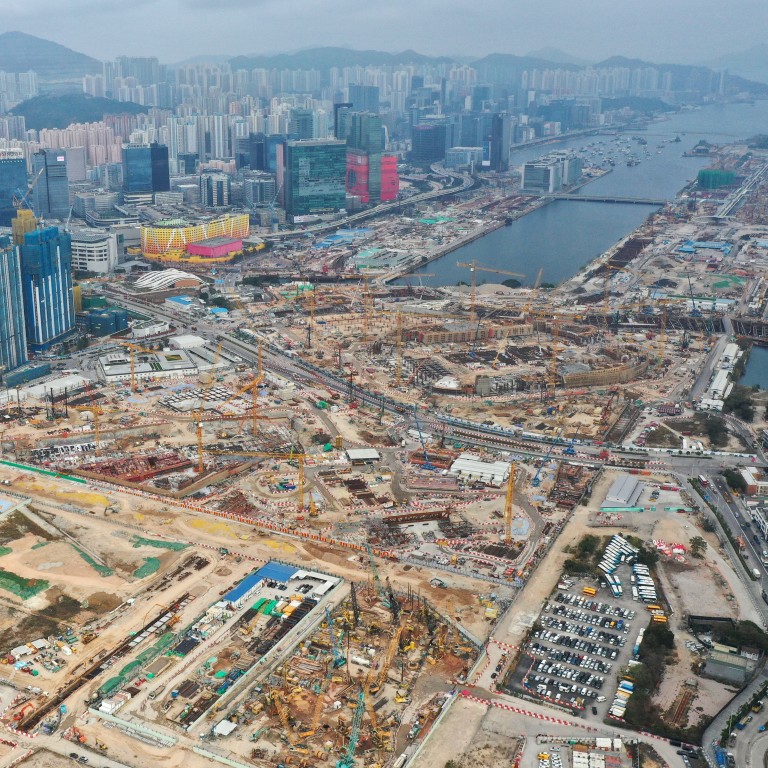
Hong Kong budget: five commercial land parcels at old airport may be used for private housing
- Plots at Kai Tak include three the government failed to sell after developers’ bids failed to meet undisclosed reserve price
- But experts warn development of the prime area in heart of Hong Kong must be balanced as too much housing could lead to problems such as traffic jams
The plots are located at the former international airport site in Kai Tak, and include three the government failed to sell over the past two years because property developers’ bids did not meet their undisclosed reserve price. They will yield about 5,800 private flats, according to officials’ preliminary estimate.
The move followed a policy change in 2018 to set aside fewer plots for sale for the private sector in favour of public housing.

While industry figures agree the rezoning could help ease the housing shortage, some caution that it could also compromise the plan to develop Kai Tak as part of a new office hub for the city.
“It makes sense due to the shortage of land for housing and also because the market is telling us that there may be some issues with the [Kai Tak sites],” said Francis Lam Ka-fai, chairman of the Institute of Surveyor’s planning and development division.
Lam noted the coronavirus pandemic had made remote working more common and lowered the demand for office space.
“Demand is not going to go up in the short term, so it’s better to convert those plots for residential use,” he said.
Can Kai Tak, Hong Kong’s former airport, take off as the city’s second business district?
The government adjusted the figure for how newly available land earmarked for housing should be split for public and private residences from 60-40 to 70-30. The change meant the government would set aside fewer plots for sale to private developers and keep more land to build more public housing.
But the decision also drew concerns that private market flats would become even more expensive with less supply.
Veteran architect Ivan Ho Man-yiu, who is a member of the Harbourfront Commission, said the rezoning proposal was not ideal for Kai Tak, but admitted it was one way to ease the housing crisis.
He urged authorities to save other areas for commercial and open space, and avoid turning Kai Tak into a strictly residential neighbourhood.
“The government needs to bridge the impact, otherwise it will create more traffic jams, increase living costs for those who need to commute from home to work and make the area very unbalanced,” Ho said.
Officials plan to turn Kai Tak into the city’s second business district, but with leisure and recreation facilities. A 28-hectare sports complex is due to be completed in late 2023, providing a 50,000-seat multipurpose stadium with a retractable roof, a 10,000-seat indoor arena and a 5,000-seat sports ground, plus retail and dining space. The site is also served by a cruise terminal.
Hong Kong withdraws Kai Tak commercial plot from sale following tepid bids by developers
Dorothy Chow, senior director of valuation advisory services at international property consultancy JLL in Hong Kong, agreed that the rezoning could help increase private housing supply.
“For the healthy and sustainable future development of Hong Kong, the government should ensure that the city has sufficient land for commercial development, and not focus solely on residential development,” she added.
According to JLL statistics, Hong Kong’s overall Grade A office vacancy rate was 9.3 per cent last month. In the core business districts of Central and Tsim Sha Tsui, the rate was 7.5 and 10.1 per cent, respectively, and reached 14.4 per cent in Kowloon East.
“From the previous tender results of commercial development sites in Kai Tak, it was revealed that demand for commercial development in that area is not huge,” Chow said. “In more traditional or established commercial areas in Kowloon East such as Kwun Tong and Kowloon Bay, the demand still exists as these areas provide lower cost options for different categories of occupiers from multinational corporates to [small and medium-sized enterprises].”
After 11 years and HK$90 million in studies, Hong Kong scraps proposed Kai Tak elevated rail link
Meanwhile, the land sale programme for the upcoming fiscal year will cover 15 residential sites, providing about 6,000 flats, 1,500 fewer than last year.
Along with redevelopment projects and sites along railway lines, the potential supply of private housing land will provide about 16,500 homes.
But only three commercial sites will be made available for sale, yielding 480,000 square metres, down from six sites last year.
The secretary for development will hold a press conference on the land sale programme on Thursday afternoon.

